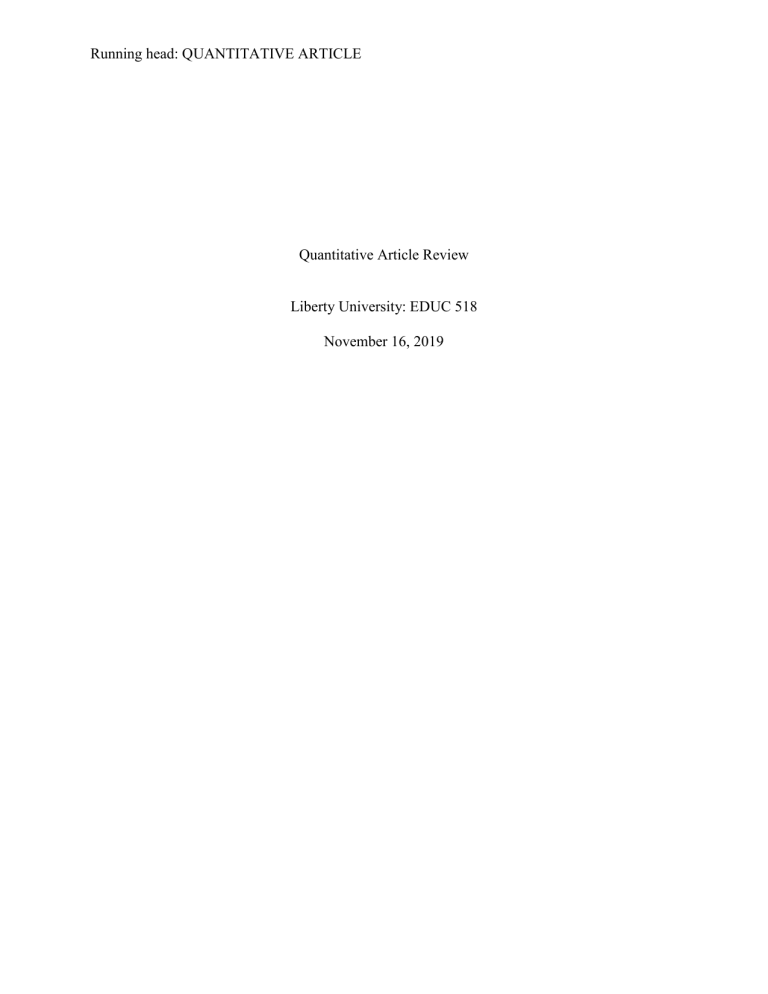
Running head: QUANTITATIVE ARTICLE Quantitative Article Review Liberty University: EDUC 518 November 16, 2019 QUANTITATIVE ARTICLE Quantitative Article Review The purpose of the study Research indicates that teachers often lack the essential knowledge, skills and confidence to identify and meet the needs of gifted and talented students. Evidence hints this lack of preparation may be related to teachers' professional development (Fraser-Seeto, Howard, & Woodcock, 2015). In 2005, the Australian Federal Government developed the Gifted and Talented Education Professional Development Package for Teachers, which is professional development package consisted of six individual modules that aimed to provide teachers with access to specialized learning to enable them to identify gifted and talented students. The impact of this professional development package remains unclear, with no published research having investigated these issues. In a quantitative study titled An Investigation of Teachers’ Awareness and Willingness to Engage with a Self-Directed Professional Development Package on Gifted and Talented Education, researchers set out with the purpose of obtaining data regarding teacher’s knowledge and use of the Gifted and Talented Education Professional Development Package (Fraser-Seeto, Howard, & Woodcock, 2015). A description of participants Initially 15 primary schools were selected at random from the 228 schools in the region. 10 schools were drawn to make up the initial list, with five more placed on a reserve list. Due to an insufficient response rate, the five reserve school were invited to participate. The intention was to recruit a sample size of approximately 100 participants. In order to achieve that, another nine randomly selected schools were invited to participant. The final sample size was made up of 96 teachers from 10 different schools educating students from Kindergarten to Year 6. The QUANTITATIVE ARTICLE majority of participants from the final sample were female (79.2%) (Fraser-Seeto, Howard, & Woodcock, 2015). The research design This study uses the non-experimental research design of a survey. Surveys are commonly used in the education field. The method of data collection A questionnaire was purposefully designed for this study to investigate teachers’ awareness and use of the Gifted and Talented Education Professional Development Package for Teachers. Questionnaire items were seven categorical questions (e.g., yes/no), five statements rated on a 5-point Likert scale (rated 0 to 4), and two open-ended response options in which participants could expand on their opinions (Fraser-Seeto, Howard, & Woodcock, 2015). A statistical analysis and the results All participants indicated that professional development was important in their being able to identify and appropriately support a gifted and talented student (with 54.2% indicating ‘very important’ and 45.8% indicating ‘somewhat important’). Only 51.0% of participants (n = 49) had undertaken some form of professional development in gifted and talented education. The results revealed that the majority (74.0%; n = 71) had no awareness of the professional development package. A further 17.7% (n = 17 participants) had heard of the professional development package but never seen it. In fact, only 5.2% (n = 5) of participating teachers had completed part of the package and only 1.0% had completed it in its entirety. In considering participants’ QUANTITATIVE ARTICLE willingness to use a gifted and talented education professional development package, 92.7% (n = 89) identified themselves as willing (Fraser-Seeto, Howard, & Woodcock, 2015). In order to analyze the date, non-parametric chi-square analyses were conducted. Chisquare analyses indicated that having undertaken professional development in gifted and talented education was significantly related to awareness of the package, χ 2 (2) = 9.05, p = .01, but not significantly related to teachers’ completion of the package, χ 2 (2) = 2.80, p = .25. Examination of descriptive statistics indicated that teachers who had undertaken professional development in gifted and talented education were more likely to have heard of (Professional Development: 24.5%; No Professional Development: 10.6%) and have seen the package (Professional Development: 14.3%; No Professional Development: 2.1%) (Fraser-Seeto, Howard, & Woodcock, 2015). Opportunities for further research This study represents an initial benchmark of the contribution this self-directed professional development package. Even though the professional development package was developed, it was not widely used by teachers. The teachers in this study stated willingness to engage with the support. Further research should be conducted to determine the factors that influence educator’s awareness and use of educational tools. Research on the impacts of professional development and self-efficacy should also be studied. QUANTITATIVE ARTICLE Threats to validity One of the threats of validity of this study is that survey research is hindered by the limits of self-reporting data. Original Insight or criticism This study was conducted in a rural region. The same study being conducted in an urban setting could have different results. “Replicate the research study in a new setting. This is a good way to determine if similar results will be found. If you find the same results with other populations and in other settings, you can be reasonably confident that the generalizations are valid” (Ary et all, 2019, p. 242). Implications of the findings Self-directed professional development provides educators with opportunities to undertake learning at their own pace. This study contributes to the broader context of this type of professional development. It supports the need for further research into the factors that impact the ongoing effectiveness of self-directed professional development. References: Ary, D., Jacobs, L.C., Walker, D.A., & K., S.I.C. (2019). Introduction to Research in Education. Boston, MA: Cengage. Fraser-Seeto, Kylie & Howard, Steven & Woodcock, Stuart. (2015). An Investigation of Teachers’ Awareness and Willingness to Engage with a Self-Directed Professional Development Package on Gifted and Talented Education. Australian Journal of Teacher Education. 40 (1). Doj:10.14221/ajte.2015v40n1.1


